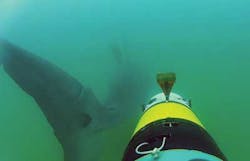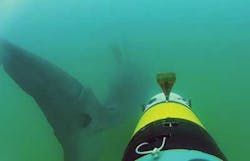Vision-enabled robot tracks great whites for Shark Week special
An autonomous underwater vehicle (AUV) with video cameras and navigational and scientific instrumentation was used to track and capture up-close footage of a Great White shark off the coast of Cape Cod in Massachusetts for the "Return of Jaws" special on the Discovery Channel's Shark Week
Known as "Shark Cam," the remote environmental monitoring unit (REMUS) uses an omnidirectional ultra-short baseline navigation system to determine the range, bearing, and depth of a tagged animal. Shark Cam then closes on the animal to a pre-determined distance and position, and films it swimming and interacting with its environment, while not interfering with the animal's behavior, according to the Woods Hole Oceanographic Institution's (Woods Hole, Mass; http://www.whoi.edu) Oceanographic Systems Laboratory.
Shark Cam, a 2.3 meter (90 inches) long robot that weights 100 lbs. (45 kg), can dive to depths of up to 100 meters, or 328 feet. It utilizes four REMUS GoPro (San Mateo, Calif.; www.gopro.com) video cameras that provide 360° field of view and an acoustic communication system, modem, and transducer which allows it to communicate with scientists on the surface every 10 to 20 seconds and to receive commands to change speed, depth, or other commands as necessary.
When deployed for the Shark Week special "Return of Jaws," the Shark Cam was able to successfully track great whites underwater for the first time. In a Q&A interview with Mental Floss, Woods Hole Oceanographic Institution marine biologist Greg Skomal said that while he had joked with his team about the sharks eating the camera, Shark Cam was completely ignored.
Vision Systems Articles Archives

